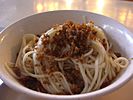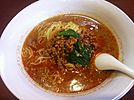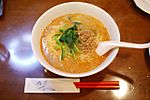Dandan noodles facts for kids
Quick facts for kids Dandan noodles |
|||||||||||||
|---|---|---|---|---|---|---|---|---|---|---|---|---|---|

Hong Kong-style dandan noodle soup (擔擔湯麵) served in a Sichuan restaurant in Shanghai with traditional red chilli oil sauce, pork, and spring onions.
|
|||||||||||||
| Chinese name | |||||||||||||
| Traditional Chinese | 擔擔麵 | ||||||||||||
| Simplified Chinese | 担担面 | ||||||||||||
| Literal meaning | "carrying-pole noodles" | ||||||||||||
|
|||||||||||||
| Japanese name | |||||||||||||
| Kanji | 担々麺 | ||||||||||||
| Kana | タンタンメン | ||||||||||||
|
|||||||||||||
Dandan noodles (also called dandanmian) are a famous noodle dish from China. They come from Sichuan cuisine, a style of cooking known for its bold flavors. The name "dandanmian" means "carrying-pole noodles."
This dish usually has a spicy sauce. It often includes special preserved vegetables, chili oil, and Sichuan pepper. Minced pork and fresh scallions are also common ingredients. The noodles can be served dry, with the sauce mixed in. Sometimes, they are served in a tasty soup.
Dandan noodles first appeared in Chengdu. This city is the capital of Sichuan province. The original dish is served in a small bowl without much soup. It has a spicy meat sauce and pickled vegetables. Peanuts and spring onions are often added on top.
A soup version of dandan noodles is popular in Hong Kong. This style is now found in many parts of China. However, in Sichuan, the traditional dry version is still the most common.
Sometimes, people add sesame paste or peanut butter to the sauce. This is especially true in the American Chinese style of the dish. When this happens, the spicy sauce might be replaced. This version is similar to "ma jiang mian," which means sesame sauce noodles.
What's in a Name?
The name "dandan" comes from a special carrying pole. Street vendors used these poles to sell the noodles. They would carry the pole over their shoulder. Two baskets hung from each end. One basket held the noodles, and the other held the sauces.
These noodles were very affordable. Local people started calling them "dandan" noodles. This was a way to remember the street vendors. The name means "noodles carried on a pole." You might also hear it called "peddler's noodles."
You might see different spellings for "dandan noodles." Some common ones are "dandan," "dundun," or "tantan." The word for noodles can also be spelled "mein." This comes from the Cantonese language.
Other Dishes Like It
The same spicy sauce used in dandan noodles is also used in other dishes. One example is "bonbon chicken" (棒棒鸡). This dish features poached chicken with the sauce.
Another Sichuan dish is "suanla chaoshou." This dish uses the sauce on steamed dumplings filled with meat.
In Japan, there is a similar dish called tantan-men. This is a type of ramen noodle soup. It uses flavors inspired by the Chinese dandan noodles.
See also
 In Spanish: Fideos dan dan para niños
In Spanish: Fideos dan dan para niños




